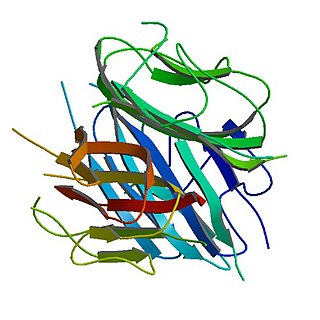Related Research Articles

Abdominal obesity, also known as central obesity and truncal obesity, is the human condition of an excessive concentration of visceral fat around the stomach and abdomen to such an extent that it is likely to harm its bearer's health. Abdominal obesity has been strongly linked to cardiovascular disease, Alzheimer's disease, and other metabolic and vascular diseases.

Lipolysis is the metabolic pathway through which lipid triglycerides are hydrolyzed into a glycerol and free fatty acids. It is used to mobilize stored energy during fasting or exercise, and usually occurs in fat adipocytes. The most important regulatory hormone in lipolysis is insulin; lipolysis can only occur when insulin action falls to low levels, as occurs during fasting. Other hormones that affect lipolysis include glucagon, epinephrine, norepinephrine, growth hormone, atrial natriuretic peptide, brain natriuretic peptide, and cortisol.

Brown adipose tissue (BAT) or brown fat makes up the adipose organ together with white adipose tissue. Brown adipose tissue is found in almost all mammals.

Adipose tissue (also known as body fat, or simply fat) is a loose connective tissue composed mostly of adipocytes. In addition to adipocytes, adipose tissue contains the stromal vascular fraction(SVF) of cells including preadipocytes, fibroblasts, vascular endothelial cells and a variety of immune cells such as adipose tissue macrophages. Adipose tissue is derived from preadipocytes. Its main role is to store energy in the form of lipids, although it also cushions and insulates the body. Far from being hormonally inert, adipose tissue has, in recent years, been recognized as a major endocrine organ, as it produces hormones such as leptin, estrogen, resistin, and cytokines (especially TNFα). In obesity, adipose tissue is also implicated in the chronic release of pro-inflammatory markers known as adipokines, which are responsible for the development of metabolic syndrome, a constellation of diseases, including type 2 diabetes, cardiovascular disease and atherosclerosis. The two types of adipose tissue are white adipose tissue (WAT), which stores energy, and brown adipose tissue (BAT), which generates body heat. The formation of adipose tissue appears to be controlled in part by the adipose gene. Adipose tissue – more specifically brown adipose tissue – was first identified by the Swiss naturalist Conrad Gessner in 1551.

The thiazolidinediones, abbreviated as TZD, also known as glitazones after the prototypical drug ciglitazone, are a class of heterocyclic compounds consisting of a five-membered C3NS ring. The term usually refers to a family of drugs used in the treatment of diabetes mellitus type 2 that were introduced in the late 1990s.

Adipocytes, also known as lipocytes and fat cells, are the cells that primarily compose adipose tissue, specialized in storing energy as fat. Adipocytes are derived from mesenchymal stem cells which give rise to adipocytes through adipogenesis. In cell culture, adipocyte progenitors can also form osteoblasts, myocytes and other cell types.

Adiponectin is a protein hormone and adipokine, which is involved in regulating glucose levels and fatty acid breakdown. In humans, it is encoded by the ADIPOQ gene and is produced primarily in adipose tissue, but also in muscle and even in the brain.

Resistin also known as adipose tissue-specific secretory factor (ADSF) or C/EBP-epsilon-regulated myeloid-specific secreted cysteine-rich protein (XCP1) is a cysteine-rich peptide hormone derived from adipose tissue that in humans is encoded by the RETN gene.
The adipokines, or adipocytokines are cytokines secreted by adipose tissue. Some contribute to an obesity-related low-grade state of inflammation or to the development of metabolic syndrome, a constellation of diseases including, but not limited to, type 2 diabetes, cardiovascular disease and atherosclerosis. The first adipokine to be discovered was leptin in 1994. Since that time, hundreds of adipokines have been discovered.

Hyperinsulinemia is a condition in which there are excess levels of insulin circulating in the blood relative to the level of glucose. While it is often mistaken for diabetes or hyperglycaemia, hyperinsulinemia can result from a variety of metabolic diseases and conditions, as well as non-nutritive sugars in the diet. While hyperinsulinemia is often seen in people with early stage type 2 diabetes mellitus, it is not the cause of the condition and is only one symptom of the disease. Type 1 diabetes only occurs when pancreatic beta-cell function is impaired. Hyperinsulinemia can be seen in a variety of conditions including diabetes mellitus type 2, in neonates and in drug-induced hyperinsulinemia. It can also occur in congenital hyperinsulinism, including nesidioblastosis.

Free Fatty acid receptor 4 (FFAR4), also termed G-protein coupled receptor 120 (GPR120), is a protein that in humans is encoded by the FFAR4 gene. This gene is located on the long arm of chromosome 10 at position 23.33. G protein-coupled receptors reside on their parent cells' surface membranes, bind any one of the specific set of ligands that they recognize, and thereby are activated to trigger certain responses in their parent cells. FFAR4 is a rhodopsin-like GPR in the broad family of GPRs which in humans are encoded by more than 800 different genes. It is also a member of a small family of structurally and functionally related GPRs that include at least three other free fatty acid receptors (FFARs) viz., FFAR1, FFAR2, and FFAR3. These four FFARs bind and thereby are activated by certain fatty acids.

Adipose differentiation-related protein, also known as perilipin 2, ADRP or adipophilin, is a protein which belongs to the perilipin (PAT) family of cytoplasmic lipid droplet (CLD)–binding proteins. In humans it is encoded by the ADFP gene. This protein surrounds the lipid droplet along with phospholipids and is involved in assisting the storage of neutral lipids within the lipid droplets.

Fibroblast growth factor 21 is a liver-secreted peptide hormone that in humans is encoded by the FGF21 gene. Together with FGF19 and FGF23, this protein is a member of the endocrine subgroup within the fibroblast growth factor (FGF) family. FGF21 is a potent, extracellularly acting metabolic regulator, whose action was discovered through in vitro phenotypic screening and diet manipulation studies in rodents., unlike canonical growth-stimulating FGFs known to stimulate mitosis, differentiation and angiogenesis in their target tissues, FGF21 exerts its action by activating FGF21 receptors located in the cell membrane of target cells. Each FGF21 receptor is composed of a transmembrane FGF receptor protein, and its complexing co-receptor β-Klotho. Loss of β-Klotho abolishes all effects of FGF21 in vitro and in vivo. In addition to its action as a hormone, FGF21 may be able to act in an autocrine fashion, or possibly also in a paracrine manner in the pancreas.

Chemerin, also known as retinoic acid receptor responder protein 2 (RARRES2), tazarotene-induced gene 2 protein (TIG2), or RAR-responsive protein TIG2 is a protein that in humans is encoded by the RARRES2 gene.

Adipogenesis is the formation of adipocytes from stem cells. It involves 2 phases, determination, and terminal differentiation. Determination is mesenchymal stem cells committing to the adipocyte precursor cells, also known as preadipocytes which lose the potential to differentiate to other types of cells such as chondrocytes, myocytes, and osteoblasts. Terminal differentiation is that preadipocytes differentiate into mature adipocytes. Adipocytes can arise either from preadipocytes resident in adipose tissue, or from bone-marrow derived progenitor cells that migrate to adipose tissue.
A number of lifestyle factors are known to be important to the development of type 2 diabetes including: obesity, physical activity, diet, stress, and urbanization. Excess body fat underlies 64% of cases of diabetes in men and 77% of cases in women. A number of dietary factors such as sugar sweetened drinks and the type of fat in the diet appear to play a role.

AdipoRon is a selective, orally active, synthetic small-molecule agonist of the adiponectin receptor 1 (AdipoR1) and adiponectin receptor 2 (AdipoR2). It activates AMPK and PPARα signaling and ameliorates insulin resistance, dyslipidemia, and glucose intolerance in db/db mice. Moreover, AdipoRon has been found to extend the lifespans of db/db mice fed a high-fat diet, as well as improve exercise endurance. The compound was discovered by Japanese researchers in 2013 via screening of a compound library, and is the first orally active, small-molecule agonist of the adiponectin receptors to be identified.

Christos Socrates Mantzoros is a Greek American physician-scientist, practicing internist-endocrinologist, teacher and researcher. He is a professor of medicine at Harvard Medical School and an adjunct professor at Boston University School of Medicine. He currently serves as the chief of endocrinology, diabetes and metabolism at the VA Boston Healthcare System, where he created de novo a leading academic division true to its tripartite mission and as the founding director of human nutrition at Beth Israel Deaconess Medical Center (BIDMC), Harvard Medical School. Finally, he holds the editor-in-chief position of the journal Metabolism: Clinical and Experimental.
The Thyroid Feedback Quantile-based Index (TFQI) is a calculated parameter for thyrotropic pituitary function. It was defined to be more robust to distorted data than established markers including Jostel's TSH index (JTI) and the thyrotroph thyroid hormone sensitivity index (TTSI).
Hepatokines are proteins produced by liver cells (hepatocytes) that are secreted into the circulation and function as hormones across the organism. Research is mostly focused on hepatokines that play a role in the regulation of metabolic diseases such as diabetes and fatty liver and include: Adropin, ANGPTL4, Fetuin-A, Fetuin-B, FGF-21, Hepassocin, LECT2, RBP4,Selenoprotein P, Sex hormone-binding globulin.
References
- ↑ "Karen Lam". Diocesan Old Girls' Association. Retrieved 2022-02-19.
- 1 2 3 "Established Endowed Professorships". The University of Hong Kong Development & Alumni Affairs Office. Retrieved 2022-02-19.
- 1 2 "Karen Lam, MBBS, MD". www.endocrine.org. Retrieved 2022-02-19.
- ↑ "Speakers at 2017 Diabetes Malaysia conference" (PDF). Diabetes Malaysia. Retrieved February 19, 2022.
- ↑ Wong, Billy SK (2017-12-17). "Surge in clinical trials helps city speed new treatments to market". South China Morning Post. Retrieved 2022-03-27.
- ↑ Cremer, John (2009-03-14). "Women of Distinction: Hard work fuels quest for success" . South China Morning Post. p. 2. ProQuest 266687557 . Retrieved 2022-03-27– via ProQuest.
- ↑ Lee, Chi Ho; Lui, David T W; Cheung, Chloe Y Y; Fong, Carol H Y; Yuen, Michele M A; Chow, Wing Sun; Woo, Yu Cho; Xu, Aimin; Lam, Karen S L (2020-04-01). "Higher Circulating Adiponectin Concentrations Predict Incident Cancer in Type 2 Diabetes - The Adiponectin Paradox". The Journal of Clinical Endocrinology and Metabolism. 105 (4): e1387–e1396. doi: 10.1210/clinem/dgaa075 . ISSN 1945-7197. PMID 32072163. S2CID 211191424.
- ↑ Xu, A.; Wang, H.; Hoo, R. L.; Sweeney, G.; Vanhoutte, P. M.; Wang, Y.; Wu, D.; Chu, W.; Qin, G.; Lam, K. S. (2009). "Selective elevation of adiponectin production by the natural compounds derived from a medicinal herb alleviates insulin resistance and glucose intolerance in obese mice". Endocrinology. 150 (2): 625–633. doi:10.1210/en.2008-0999. ISSN 0013-7227. PMC 2732290 . PMID 18927219.
- ↑ Chow, Wing Sun; Tso, Annette Wai Kwan; Xu, Aimin; Yuen, Michele Mae Ann; Fong, Carol Ho Yi; Lam, Tai Hing; Lo, Su Vui; Tse, Hung Fat; Woo, Yu Cho; Yeung, Chun Yip; Cheung, Bernard Man Yung (2013-01-23). "Elevated Circulating Adipocyte‐Fatty Acid Binding Protein Levels Predict Incident Cardiovascular Events in a Community‐Based Cohort: A 12‐Year Prospective Study". Journal of the American Heart Association. 2 (1): e004176. doi:10.1161/JAHA.112.004176. ISSN 2047-9980. PMC 3603238 . PMID 23525430.
- ↑ Lee, Chi-Ho; Lui, David T. W.; Lam, Karen S. L. (2021). "Adipocyte Fatty Acid-Binding Protein, Cardiovascular Diseases and Mortality". Frontiers in Immunology. 12: 589206. doi: 10.3389/fimmu.2021.589206 . ISSN 1664-3224. PMC 8017191 . PMID 33815359.
- ↑ Xu, Aimin; Tso, Annette W.K.; Cheung, Bernard M.Y.; Wang, Yu; Wat, Nelson M.S.; Fong, Carol H.Y.; Yeung, Dennis C.Y.; Janus, Edward D.; Sham, Pak C.; Lam, Karen S.L. (2007-03-27). "Circulating Adipocyte–Fatty Acid Binding Protein Levels Predict the Development of the Metabolic Syndrome". Circulation. 115 (12): 1537–1543. doi:10.1161/CIRCULATIONAHA.106.647503. PMID 17389279. S2CID 9975535.
- 1 2 Harris, Margaret (2009-05-23). "Karen Lam Siu-ling: tackling diabetes in Hong Kong". The Lancet. 373 (9677): 1755. doi:10.1016/S0140-6736(09)60970-3. ISSN 0140-6736. PMID 19465220. S2CID 30592445.
- ↑ Wiseman, Alison (1994-01-25). "Experts call for diabetes fight to be stepped up". South China Morning Post. p. 3. Retrieved 2022-03-27.
- ↑ "Honors for outstanding women". South China Morning Post. 5 July 2008. p. 3 – via ProQuest.